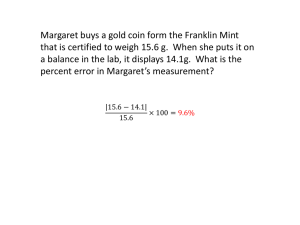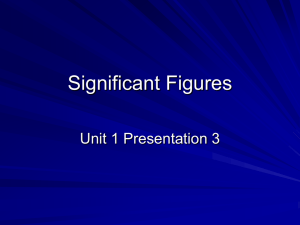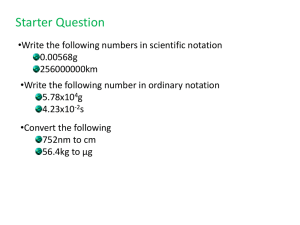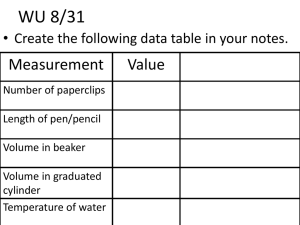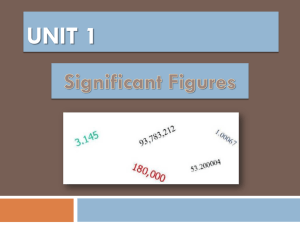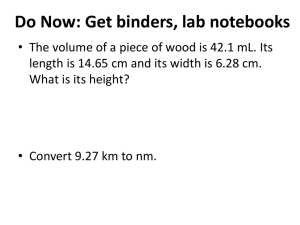Significant Figures
advertisement
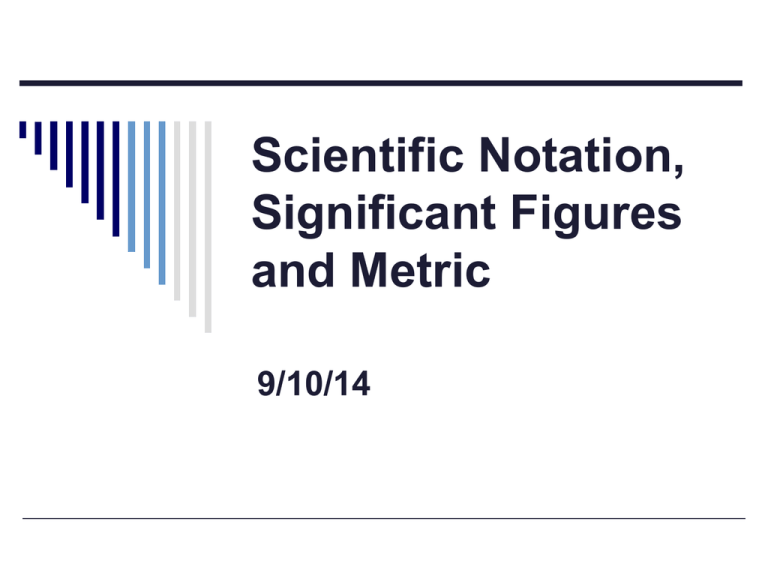
Scientific Notation,
Significant Figures
and Metric
9/10/14
Scientific Notation
The components of scientific notation:
8.238 x 10-31
“8.238” is the coefficient
“x 10” is the base
“-31” is the exponent
Where the coefficient has to be a number:
1 ≤ coefficient < 10
Significant Figures
Significant Figures (sig. figs.): the number of
digits that carry meaning contributing to the
precision of a measurement or calculated
data.
Precision and Accuracy
Low Accuracy
High Precision
High Accuracy
Low Precision
High Accuracy
High Precision
Significant Figures
Each recorded measurement has a certain
number of significant figures.
Calculations done on these measurements
must follow the rules for significant figures.
Placeholders, or digits that have not been
measured or estimated, are not considered
significant.
Significant Figures
There are 5 rules to determine which zeros in
a number are significant or not.
Rules for Significant Figures
Rule #1: All non-zero digits (1-9) are
significant.
For example:
453
number of sig figs______
345.21 number of sig figs______
Rules for Significant Figures
Rule #2: Zeroes between non-zero digits are
significant.
For example:
12.007
number of sig figs______
2014
number of sig figs______
Rules for Significant Figures
Rule #3: If a number ends in zeroes, the
zeroes to the right are NOT significant IF
there is NO decimal point present.
For example:
47100
number of sig figs______
20060
number of sig figs______
40000
number of sig figs______
Rules for Significant Figures
Rule #4: Zeroes to the left of the first non-
zero digit are NOT significant.
For example:
1.02
0.12
0.00127
0.00040301
number of sig figs______
number of sig figs______
number of sig figs______
number of sig figs______
Rules for Significant Figures
Rule #5: If a number ends in zeroes to the
right of the decimal point, those zeroes are
significant.
For example:
2
number of sig figs______
2.0
number of sig figs______
2.00
number of sig figs______
2.000
number of sig figs______
{This signifies greater precision.}
The Atlantic - Pacific Rule
for Significant Figures
When determining the number of significant
figures ask the question:
“Does the number have a decimal point?”
(YES or NO answer)
If YES, then think of “P” for Present and the
Pacific ocean
If NO, then think of “A” for Absent and the
Atlantic ocean
The Atlantic and Pacific Rule
for Significant Figures
The Atlantic and Pacific Rule
for Significant Figures
"P" for "Present". This means that we imagine an
arrow coming in from the Pacific ocean, from the
left side
"A" for "Absent". This means that we imagine an
arrow coming in from the Atlantic ocean, the right
side.
The Atlantic and Pacific Rule
for Significant Figures
Look for the first non zero number starting
from that direction
That number, and all other numbers following
it are considered to be significant
For “P” the numbers to the right of the first
non zero number
For “A” the numbers to the left of the first
non zero number
Examples
1) 0.020110
2) 730800
3) 3300
4) 3300.0
Rounding Sig. Figs.
Rounding Sig. Figs.
The goal is to round the number to
the appropriate amount of sig. figs.
without changing the value too much.
Rounding Calculations
For multiplication and division:
Round to the number that has the least
amount of sig. figs.
Note: There are different rules for addition
and subtractions
Rounding Sig. Figs.
Look at the left most non-zero numbers to identify
the ones that you will keep
If the number to the right of the last digit is 5 or
higher round up, 4 or lower round down
LEFT of Decimal: Replace non significant
figures with zeroes if they are to the LEFT of the
decimal point
RIGHT of Decimal: Drop non significant figures
if they are to the RIGHT of the decimal point
Examples in Your Notes
1) 43252202 to 3 sig figs
43252202 (5 = 5 so round up and replace
non sig. figs. with zeros)
43300000
2) 0.0073384658419 to 4 sig figs
0.0073384658419 (4 < 5 so round down and
drop non sig. figs.)
0.007338
Examples in Your Notes
3) 47.66666667 to 5 sig figs
47.66666667 (6 > 5 so round up and drop non
sig. figs.)
47.667
4) 794951.741583 to 2 sig figs
794951.741583 (4 < 5 so round down and
replace non sig. figs. with zeroes AND drop non
sig. figs. to the right of the decimal)
790000
Rounding Calculations
Examples
1. 5.50 × 2.00
2. 2.437 × 10-12 / 4.5 × 1014
Rounding Calculations
Examples
1. 5.50 × 2.00
Calculator reads “11”
Answer is 11.0
2. 2.437 × 10-12 / 4.5 × 1014
Calculator reads “5.415555556E-27”
Answer is 5.4 × 10-27
Lab Rubric
1st column “Self Evaluation”
2nd column “Peer Evaluation” (student initials)
3rd column “Self Evaluation #2”
4th column “Teacher Evaluation”
Metric Units (base unit)
Quantity
Base Unit
Symbol
Length
Meter
m
Mass
Gram
g
Time
Second
s
Volume
Liter
L
Force
Newton
N
Energy
Joule
J
Metric Prefixes
*Learn highlighted ones!
Prefix
Prefix Symbol
Multiplier
mega-
M
106 (1000000)
kilo-
k
103 (1000)
BASE UNIT
-
100 (1)
centi-
c
10-2 (0.01)
milli-
m
10-3 (0.001)
micro-
μ
10-6 (0.000001)
Extra Practice
Sig. Figs. Practice
Ex 1) 0.020110
Ex 2) 730800
1) 48001
2) 9807000
3) 0.008401
4) 40.500
5) 64000
6) 64000.
7) 64000.00
8) 0.0107050
Sig. Figs. Practice
Ex 1) 0.020110
Ex 2) 730800
1) 48001
2) 9807000
3) 0.008401
4) 40.500
5) 64000
6) 64000.
7) 64000.00
8) 0.0107050
Ex 1) 0.020110 (5 sig. figs.)
Ex 2) 730800 (4 sig. figs)
1) 48001 (5 sig. figs.)
2) 9807000 (4 sig. figs.)
3) 0.008401 (4 sig. figs.)
4) 40.500 (5 sig. figs.)
5) 64000 (2 sig. figs.)
6) 64000. (5 sig. figs.)
7) 64000.00 (7 sig. figs.)
8) 0.0107050 (6 sig. figs.)
Rounding Practice
1. 0.0018563333 to 3 sig. figs.
2. 34498221 to 2 sig. figs.
3. 4781.2233 to 3 sig figs.
4. 568.7893201 to 5 sig. figs.
5. 67488133 to 1 sig. fig.
6. 0.0219999 to 2 sig. figs.
7. 4.7004021 to 4 sig. figs.
8. 998701 to 1 sig. fig.
Rounding Practice
1. 0.0018563333 to 3 sig. figs.
1. 0.00186
2. 34498221 to 2 sig. figs.
2. 34000000
3. 4781.2233 to 3 sig figs.
3. 4780
4. 568.7893201 to 5 sig. figs.
4. 568.79
5. 67488133 to 1 sig. fig.
5. 70000000
6. 0.0219999 to 2 sig. figs.
6. 0.022
7. 4.7004021 to 4 sig. figs.
7. 4.700
8. 998701 to 1 sig. fig.
8. 1000000

